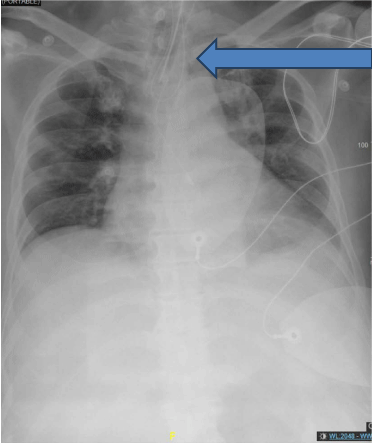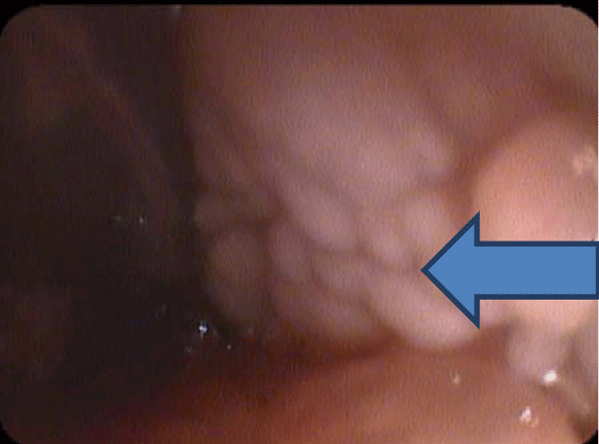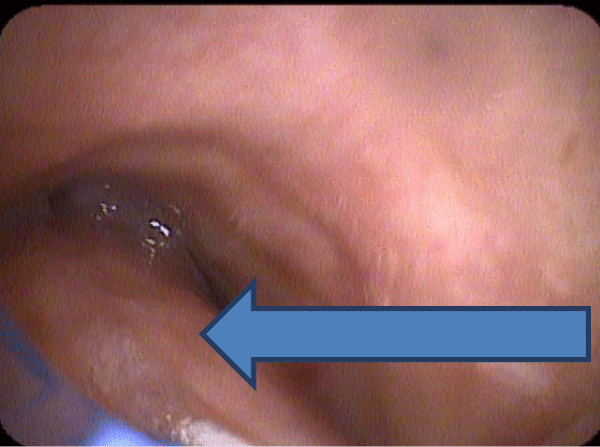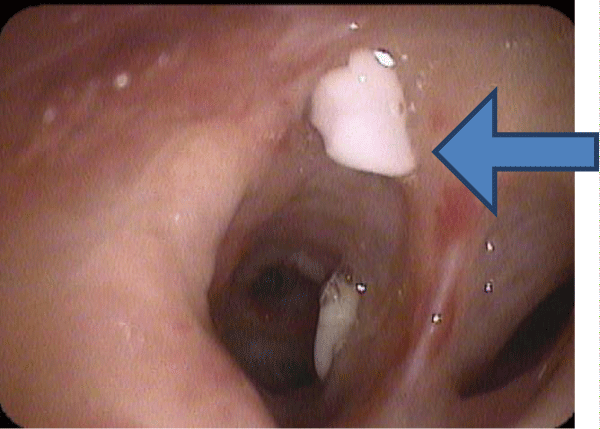Case Report
A Consequence of Edentulism in an Elderly Patient
Lee Eng Kiang*
Intensive Care Medicine, Ng Teng Fong General Hospital, Singapore
*Corresponding author: Lee Eng Kiang, Senior Consultant, Intensive Care
Medicine, Ng Teng Fong General Hospital, Singapore, Tel: 6591144378; Email:
eng_kiang_lee@nuhs.edu.sg
Submitted: 26 April, 2019; Accepted: 10 May, 2019; Published: 13 May, 2019
Cite this article: Kiang LE (2019) A Consequence of Edentulism in an Elderly Patient.
JSMC Clin Case Rep 4: 3.
We report the case of a severe airway obstruction from a foreign body in the esophagus of a 77-year-old gentleman who subsequently
went into asystole secondary to severe hypoxia. The patient was admitted to the hospital for cellulitis of the lower limb and was having
dinner when he swallowed a piece of steamed fish of a diameter of approximately 4 cm. It lied horizontally in the esophagus and about 7
cm above the carina. It resulted in an extrinsic pressure posteriorly on the trachea, leading to complete occlusion of the airway. The patient
struggled to breath and subsequently collapsed from the asphyxia.
The patient was of sound mind with ahistory of hypertension and ischaemic heart disease. He hadnormal upper teeth but there was
no documentation of dentures for the lower teeth.He was on normal regular diet at home and he continued to receive normal diet during
his 4 day hospitalisation in the general ward.
The importance of good dental hygiene and a good set of teeth for mastication and swallowing are prerequisite for good digestion and
a good quality of life.
Keywords: Choking; Food; Foreign body airway obstruction; Geriatric
A literature search revealed that it is uncommon to have a
case of airway obstruction from a foreign body in the esophagus
of an adult [1]. The two cases mentioned in these reports were
patients with impaired mental capacities. Most of the cases
are reported in young children and these are generally, from
swallowing of toys and obstructions occurred due to a relatively
soft muscular trachea that is not well developed in young children
[2,3]. However, other reported cases of airway obstruction in
children and in adults are related to rare causes of a mucocele in
the esophagus [4] or displacement of a stent in the esophagus [5].
There are however a series of studies that showed a significant
increase incident of food choking in the elderly population
in Japan [6] and association with depressed mental status or
impaired swallowing reflexes [7]. The study on elderly patients
in Japan showed favourable outcome if by stander resuscitation
was started earlywhen choking was detected but unfortunately
this was not the case in this patient.
This 77-year-old male with a background history of
hypertension and ischemic heart disease was admitted for
septicemia from a leg ulcer. He recovered very well with
appropriate antibiotics therapy after 4 days and was due for
discharge home when the accident occurred. He was having his dinner and was eating slowly when he was noted to be choking by
the patient next to his bed and help was activated immediately. He
was in asystole within a few minutes and he received continuous
external cardiac compression during the attempt to intubate him
in the general ward. It was noted to be a grade 3 intubation and a
lot of food particles were noted in the oropharynx.
The peak pressure was noted to be high and persistently above
40 cm H2O after he was successfully intubated. The saturation
was persistently below 90% and only reverted to 100% with
a FiO2 of 100%. The asystole also reverted to sinus tachycardia
with 2 doses of intravenous adrenaline and after twenty minutes
of resuscitation. The patient was subsequently brought to ICU for
mechanical ventilator support and monitoring. An attempt was
made to place a nasogastric tube but the tube kept coiling back
into the oropharynx, Figure 1.
A surgical referral was made for gastro-endoscopy which
was performed immediately. A piece of fish was discovered in
the upper esophagus and it was successfully fragmented and the
peak airway pressure improved significantly.
The patient was on full ventilator support and received
sedation and therapeutic temperature management for at least
24 hours. Despite all these he didn`t show any improvement of
his conscious level over the next 72 hours and a non-contrast CT
scan of the head showed extensive ischemic changes of multiple
sites in the brain. The family was updated of the above changes
and in view of the poor prognosishe was extubated and was
managed conservatively.
It is unusual to have an accident like this in a cognitively intact
patient who had been eating solid food without any complication
for four days. The diet he took was analysed closely and we noted
that the steam fish was the only meat that was served in large
portion on the fourth day. The rest was served in smaller portions
and did not result in any complications. No documented difficulty
in swallowing prior to this accident was noted.
The case reports related to similar incidents are generally
associated with the swallowing of foreign bodies in children
or adults with psychiatric disorders. The airway occlusion
was attributed to narrowing of the trachea from extrinsic
compression of the soft muscular trachea in young children
(Figures 2 and 3). Esophagealmucoceles are not common locally and
more often reported in children. To our best knowledge the
use of expansible esophageal stent in esophageal carcinoma in
Singapore is not common and migration of aesophageal stent has
not been reported locally [8].
Singapore is a rapidly aging society and it has been postulated
that a third of the population will be above the age of 65 years
in the year 2020. Falling birtfhrate with better health care has
resulted in an increasing portion of elderly in the population.
There is a lack of data to compare edentulism in industrialised
developed countries, but it can be safely assumed that retention
of natural dentition is increasing in these countries due to better
oral care and awareness in some these developed nations.
However, the common oral conditions that persist in the elderly are tooth loss, dental caries, peridontitis, dry mouth and oral
precancer /cancer and these conditions may precipitate adverse
complications (Figure 4).
Edentulism is associated with poororal health related quality
of life as it may precipitate undernutrition and subsequent
fragility. Currently dental assessment is not a routine preadmission
requirement and feeding in the elderly patients is not
supervised unless there is evidence that the patients are unable
to feed themselves. A study done in a local nursing home in 2006
by a team of dentists showed a high prevalence of edentulism
and poor dental care in the elderly residents [9]. A total of 265
residents were reviewed and they found that edentulism was
common, 41% was completely edentulous and another 29% was
completely edentulous in either the maxilla or mandible. The rest
had partial dentures. They also noted the extent of untreated
decay and retained roots among the elderly residents was high too.
The integration of dental and medical health is critical for
people of all ages. Early detection of oral diseases and poor
dentition through a concise examination can lead to timely
management of systemic diseases and improve quality of life. A
recent US CDC survey done showed that patients above the age of
65 years old were twice likely to visit a dentist versus a primary
care physician [10].
Currently in Singapore we do not have enough local data
to support mandatory elderly dental care .However if our local
primary care physicians can encourage their elderly patients to
make more routine visits to see their dentists then we may be
able to have better dental hygiene and less related complications.
This case highlighted the challenges of providing and
delivering good dental care in the elderly age group of patients
locally. The patients themselves may not wish to seek dental
care and other disciplines of medicine may not take dental issues
seriously enough to make a referral. The selection of diet may not
have been taken into consideration in the absence of a good set of
functional teeth, natural or dentures. It has always been assumed
that solid diet can be served in a cognitively intact patient but
the absence of a set of functional dentition for chewing may
contribute to morbidity and mortality.
 Figure 1: A bronchoscopy was done to elicit the cause of the high peak
airway pressure. The oropharynx appeared edematous in figure 2 and
the posterior wall of the trachea was noted to be pushed forward with
close to complete occlusion of the trachea in figure 3. Rice particles
were noted in both bronchi but soilage was minimum in figure 4. View Figure
Figure 1: A bronchoscopy was done to elicit the cause of the high peak
airway pressure. The oropharynx appeared edematous in figure 2 and
the posterior wall of the trachea was noted to be pushed forward with
close to complete occlusion of the trachea in figure 3. Rice particles
were noted in both bronchi but soilage was minimum in figure 4. View Figure
 Figure 2: The oropharynx appeared edematous. View Figure
Figure 2: The oropharynx appeared edematous. View Figure
 Figure 3: Complete occlusion of the trachea by posterior compression. View Figure
Figure 3: Complete occlusion of the trachea by posterior compression. View Figure
 Figure 4: Rice particles were noted in both bronchi but soilage was minimum. View Figure
Figure 4: Rice particles were noted in both bronchi but soilage was minimum. View Figure






























